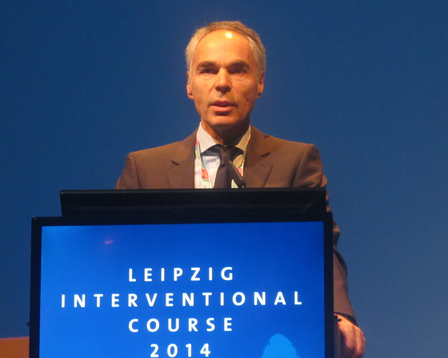
One year results from the prospective, multicentre, randomised, core lab-adjudicated FAIR trial comparing drug-eluting balloon to standard percutaneous transluminal angioplasty for the treatment of superficial femoral artery in-stent restenosis showed positive outcomes for the drug-eluting balloon.
“Angioplasty of femoropopliteal in-stent restenosis with the IN.PACT Admiral drug-eluting balloon (Medtronic) is safe and efficacious. Treatment with the drug-eluting ballloon results in significantly decreased restenosis and clinically-driven re-interventions vs. percutaneous angioplasty through six and 12 months,” said Hans Krankenberg, Heart and Vascular Centre Bad Bevensen, Germany.
Reporting one-year data at Leipzig Interventional Course (LINC; 28–31 January, Leipzig, Germany), Krankenberg told attendees that the occurrence of superficial femoral artery in-stent restenosis was high. “With stenting increasingly being performed in the superficial artery, more patients will require repeat treatments for in-stent restenosis. There is currently no consensus about the treatment of choice. We have registry data that indicate the superiority of drug-eluting balloons in this setting,” he said.
The FAIR trial’s objective was to assess safety and efficacy of angioplasty with drug-eluting balloon vs. standard angioplasty for the treatment of symptomatic superficial femoral artery in-stent restenosis. The primary endpoint was binary (≥50%) restenosis rate at six months as assessed by duplex ultrasound corelab adjudication (PSVR≥2.4)
The secondary endpoints were primary angiographic success (<50% residual stenosis), six-month recurrent in-stent restenosis (≥70%) and 12-month recurrent in-stent restenosis (≥50%), six- and 12-month clinically-driven target lesion revascularisation, and clinical/haemodynamic assessment (walking distance, ankle brachial index, Rutherford category) at one, six and 12 months. The investigators also assessed the major adverse vascular events (MAVE) at 12 months.
Patients who had Rutherford class 2–4 lesions and superficial femoral artery in-stent restenosis between 70–100% as assessed by duplex ultrasound were included. Further, to be included, patients had to have a target lesion length of 1–20cm with guaranteed distal run-off.
One hundred and nineteen patients were randomised between January 2010 and November 2012 in five participating German centres to either receive a drug-eluting balloon (n=62) or percutaneous transluminal angioplasty (n=57). Clinical and functional follow-up was at one, six and 12 months with duplex ultrasound imaging at six and 12 months.
“Patient demographics were well-matched in both groups with the number of diabetic patients being insignificantly higher in the drug-eluting balloon group. The baseline lesion characteristics were equally well-matched with the mean diameter stenosis being 89% in both arms and lesion length around 8cm in both arms. Predilatation was performed in the drug-eluting balloon arm in almost all patients and post-dilatation was quite rare,” said Krankenberg.
Krankenberg noted that primary angiographic success was 59% in the drug-luting balloon arm and almost 80% in the angioplasty arm. “At six months, recurrent restenosis (which was the primary endpoint) was 15.4% in the drug-eluting balloon arm and 44.7% in the angioplasty group and this difference was statistically significant. Six-month secondary patency was also statistically significant at 87% in the drug-eluting group and 65.2% of the angioplasty group.
“When we looked at recurrence of restenosis at 12 months, it was 29.5% in the drug-eluting balloon arm and 62.5% in the angioplasty arm, so we have a stable outcome that is statistically significant. Secondary patency rate was quite similar in both arms,” Krankenberg reported.
The target lesion revascularisation was 19.8% in the drug-eluting balloon group and 52.6%in the angioplasty group. Walking capacity and ankle brachial index were similar in both groups during the follow-up at six and 12 months.
“Major adverse events were quite rare; we had some deaths in both arms but these were unrelated to the procedure,” said Krankenberg. “The FAIR trial demonstrated a similar clinical and functional benefit at 12-months in both arms of the trial at the price of significantly higher target lesion revascularisation rate in the angioplasty arm,” Krakenberg concluded.













